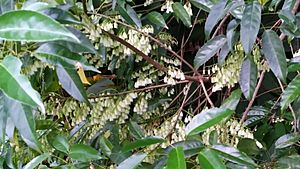Michael's quandong facts for kids
Quick facts for kids Michael's quandong |
|
|---|---|
 |
|
| Elaeocarpus culminicola flowering | |
| Conservation status | |
| Scientific classification | |
| Genus: |
Elaeocarpus
|
| Species: |
culminicola
|
| Synonyms | |
|
|
Michael's quandong, also known by its scientific name Elaeocarpus culminicola, is a type of flowering tree. It belongs to the plant family called Elaeocarpaceae. You can find this tree growing naturally in parts of Asia, like Malesia, and Australia. It has cool wavy leaves with edges that are either wavy or look like tiny teeth. When it blooms, it has clusters of white, cream, or pink flowers. Later, it grows round fruits.
Contents
What Michael's Quandong Looks Like
Michael's quandong is an evergreen tree. This means it keeps its leaves all year round. It can grow up to 25 meters (about 82 feet) tall. Its trunk can be up to 25 centimeters (about 10 inches) wide.
Leaves and Branches
The leaves of this tree are shiny and dark green. They are shaped like narrow ovals, spears, or eggs. Each leaf is about 6.7 to 13.7 centimeters (2.6 to 5.4 inches) long. They are also about 2.4 to 3.7 centimeters (0.9 to 1.5 inches) wide.
The leaves grow on a stalk called a petiole. This stalk is about 1.3 to 4 centimeters (0.5 to 1.6 inches) long. The edges of the leaves can be wavy or have small teeth. They grow in a spiral pattern around the branches. You will often see them grouped together at the end of the branches.
Flowers and Fruit
The flowers of Michael's quandong grow in clusters called racemes. These clusters can be up to 4 centimeters (1.6 inches) long. They are attached to the twig behind or below the leaves. Each flower has its own small stalk, called a pedicel, which is up to 1 centimeter (0.4 inches) long.
The flowers have a strong smell, but it's not always a pleasant one. Each flower has five sepals, which are like small leaf-like parts, about 0.68 to 0.9 centimeters (0.27 to 0.35 inches) long. It also has five petals. These petals are white, cream, or pink. They are about 0.75 to 1 centimeter (0.3 to 0.4 inches) long. The petals have about 26 small lobes or cuts at their tips. Inside the flower, there are about 25 to 40 stamens, which are the parts that produce pollen.
The tree usually flowers a lot in late winter. After flowering, bright blue fruits appear. These fruits are round or slightly oval. They are about 1.3 to 1.5 centimeters (0.5 to 0.6 inches) long. They are also about 1.2 centimeters (0.47 inches) wide. These fruits are a type of stone fruit, meaning they have a hard pit inside. They appear in late spring and can stay on the branches until the next flowering season.
How Michael's Quandong Got Its Name
The scientific name for this tree, Elaeocarpus culminicola, was first officially described in 1892. A botanist named Otto Warburg gave it this name. He wrote about it in a scientific journal called Botanische Jahrbücher für Systematik, Pflanzengeschichte und Pflanzengeographie. He studied samples of the tree that were collected in 1888 from the Finisterre Range.
The second part of its scientific name, culminicola, has a special meaning. It comes from Latin words and means "peak dweller." This tells us that the tree often grows on mountain peaks or high places.
Where Michael's Quandong Grows
Michael's quandong grows naturally in several places. You can find it in the Philippines, Sulawesi, and the Maluku Islands. It also grows in New Guinea and the Bismarck Archipelago. In Australia, it is found in the Northern Territory and Queensland.
This tree usually grows in the understorey of well-developed rainforests. The understorey is the layer of plants that grow beneath the main canopy of taller trees. It often likes to grow in wet or swampy areas.
Animals That Interact With This Tree
The bright blue fruits of the Elaeocarpus culminicola tree are an important food source. Large birds called cassowaries enjoy eating these fruits.
How People Use Michael's Quandong
The wood from Michael's quandong is a type of commercial hardwood. This means its timber is strong and valuable. It can be used for various purposes, like building or making furniture.
Gallery
-
Specimen from Auckland Museum





